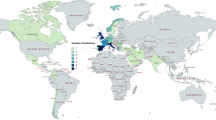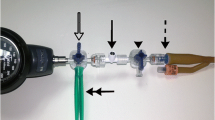Abstract
Background
Both air and radiopaque liquid contrast are used to reduce ileocolic intussusception under fluoroscopy. Some suggest air lowers radiation dose due to shorter procedure times. However, air enema likely lowers radiation dose regardless of fluoroscopy time due to less density over the automatic exposure control cells.
Objectives
We test the hypothesis that air enema reduction of ileocolic intussusception results in lower radiation dose than liquid contrast enema independent of fluoroscopy time. We describe a role for automatic exposure control in this dose difference.
Materials and methods
We retrospectively evaluated air and liquid intussusception reductions performed on a single digital fluoroscopic unit during a 26-month period. We compared patient age, weight, gender, exam time of day and year, performing radiologist(s), radiographic image acquisitions, grid and magnification use, fluoroscopy time and dose area product. We compared categorical and continuous variables statistically using chi-square and Mann-Whitney U tests, respectively.
Results
The mean dose area product was 2.7-fold lower for air enema, 1.3 ± 0.9 dGy·cm2, than for liquid, 3.5 ± 2.5 dGy·cm2 (P<0.005). The mean fluoroscopy time was similar between techniques. The mean dose area product/min was 2.3-fold lower for air, 0.6 ± 0.2 dGy·cm2/min, than for liquid, 1.4 ± 0.5 dGy·cm2/min (P<0.001). No group differences were identified in other measured dose parameters.
Conclusion
Fluoroscopic intussusception reduction using air enema uses less than half the radiation dose of liquid contrast enema. Dose savings are independent of fluoroscopy time and are likely due to automatic exposure control interaction.


Similar content being viewed by others
References
Savoie KB, Thomas F, Nouer SS et al (2017) Age at presentation and management of pediatric intussusception: a pediatric health information system database study. Surgery 161:995–1003
Sadigh G, Zou KH, Razavi SA et al (2015) Meta-analysis of air versus liquid enema for intussusception reduction in children. AJR Am J Roentgenol 205:W542–W549
Flaum V, Schneider A, Gomes Ferreira C et al (2016) Twenty years' experience for reduction of ileocolic intussusceptions by saline enema under sonography control. J Pediatr Surg 51:179–182
Stein-Wexler R, O'Connor R, Daldrup-Link H, Wootton-Gorges SL (2015) Current methods for reducing intussusception: survey results. Pediatr Radiol 45:667–674
Hannon E, Williams R, Allan R, Okoye B (2014) UK intussusception audit: a national survey of practice and audit of reduction rates. Clin Radiol 69:344–349
Jenke AC, Klaassen-Mielke R, Zilbauer M et al (2011) Intussusception: incidence and treatment-insights from the nationwide German surveillance. J Pediatr Gastroenterol Nutr 52:446–451
Beres AL, Baird R (2013) An institutional analysis and systematic review with meta-analysis of pneumatic versus hydrostatic reduction for pediatric intussusception. Surgery 154:328–334
Shiels WE, Kirks DR, Keller GL et al (1993) John Caffey award. Colonic perforation by air and liquid enemas: comparison study in young pigs. AJR Am J Roentgenol 160:931–935
Hernanz-Schulman M, Vanholder R, Waterloos MA et al (2000) Effect of radiographic contrast agents on leukocyte metabolic response. Pediatr Radiol 30:361–368
Hernanz-Schulman M, Foster C, Maxa R et al (2000) Experimental study of mortality and morbidity of contrast media and standardized fecal dose in the peritoneal cavity. Pediatr Radiol 30:369–378
Daneman A, Alton DJ, Ein S et al (1995) Perforation during attempted intussusception reduction in children--a comparison of perforation with barium and air. Pediatr Radiol 25:81–88
Phelan E, de Campo JF, Malecky G (1988) Comparison of oxygen and barium reduction of ileocolic intussusception. AJR Am J Roentgenol 150:1349–1352
Guo JZ, Ma XY, Zhou QH (1986) Results of air pressure enema reduction of intussusception: 6,396 cases in 13 years.
Stringer DA, Ein SH (1990) Pneumatic reduction: advantages, risks and indications. Pediatr Radiol 20:475–477
Parkes K, Chapman S (1988) Pneumatic reduction of ileo-colic intussusception in children. Radiography 54:147–150
Meyer JS, Dangman BC, Buonomo C, Berlin JA (1993) Air and liquid contrast agents in the management of intussusception: a controlled, randomized trial. Radiology 188:507–511
Hadidi AT, El Shal N (1999) Childhood intussusception: a comparative study of nonsurgical management. J Pediatr Surg 34:304–307
Miller DL, Balter S, Cole PE et al (2003) Radiation doses in interventional radiology procedures: the RAD-IR study: part I: overall measures of dose. J Vasc Interv Radiol 14:711–727
Fletcher DW, Miller DL, Balter S, Taylor MA (2002) Comparison of four techniques to estimate radiation dose to skin during angiographic and interventional radiology procedures. J Vasc Interv Radiol 13:391–397
Thomas RD, Fairhurst JJ, Roberts PJ (1993) Effective dose during screening monitored intussusception reduction. Clin Radiol 48:189–191
Persliden J, Schuwert P, Mortensson W (1996) Comparison of absorbed radiation doses in barium and air enema reduction of intussusception: a phantom study. Pediatr Radiol 26:329–332
Rao AG, Simmons CE Sr, Thacker PG et al (2016) Radiation exposure contribution of the scout abdomen radiograph in common pediatric fluoroscopic procedures. Pediatr Radiol 46:1241–1248
Shiels WE 2nd, Maves CK, Hedlund GL, Kirks DR (1991) Air enema for diagnosis and reduction of intussusception: clinical experience and pressure correlates. Radiology 181:169–172
Henderson AA, Anupindi SA, Servaes S et al (2013) Comparison of 2-view abdominal radiographs with ultrasound in children with suspected intussusception. Pediatr Emerg Care 29:145–150
Heenan SD, Kyriou J, Fitzgerald M, Adam EJ (2000) Effective dose at pneumatic reduction of paediatric intussusception. Clin Radiol 55:811–816
Author information
Authors and Affiliations
Corresponding author
Ethics declarations
Conflicts of interest
None
Rights and permissions
About this article
Cite this article
Kaplan, S.L., Magill, D., Felice, M.A. et al. Intussusception reduction: Effect of air vs. liquid enema on radiation dose. Pediatr Radiol 47, 1471–1476 (2017). https://doi.org/10.1007/s00247-017-3902-1
Received:
Revised:
Accepted:
Published:
Issue Date:
DOI: https://doi.org/10.1007/s00247-017-3902-1




